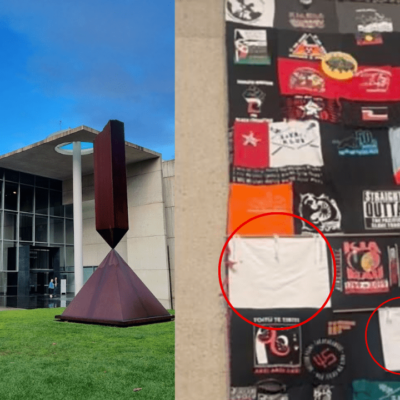
Author Catherine Kirwan chooses A View Of Cork From Audley Place
Catherine was born in Waterford, studied in UCC, and lives and works as a solicitor in Cork.
She has three best-selling crime fiction novels and is working on her fourth. Cork city locations play a central role in her work, and Catherine has chosen a painting that is a panorama of many Cork landmarks, even though it was painted over 250 years ago.
A View Of Cork From Audley Place was painted by John Butts around 1750. Cork-born Butts taught many successful Cork artists including Nathaniel Grogan and James Barry, and died at just 37 in 1765.
One of very few of his signed works in existence, A View Of Cork From Audley Place shows the vista from Bell’s Field at the top of Patrick’s Hill.
Catherine says: “This is an iconic painting in the Crawford collection, and something I’m really familiar with over many, many years. I can’t even tell you how many times I’ve given this on postcards or greeting cards, or even on fridge magnets as presents to people.
“The reason I like it so much is because, although it’s sort of a constructed version of Cork, it still gives you a real sense of what the city is like. You can see the green hills over there, which are now covered in houses.
It’s a view from a part of the city which a lot of people will actually know from The Young Offenders TV show: it’s where Jock and Connor often sit.
“You get this sense of the panorama of the city. You can see Patrick Street, but actually, it wasn’t a street then; it was a river. And you can see the building that we’re actually in now, Crawford Art Gallery. At that time, it was the old Customs House, and it doesn’t look quite the same as the Opera House wasn’t there.
“You just get a sense of this kind of verdant exterior and the really busy, crammed city that’s in there. Although many of the buildings have changed, the feeling of the city is the same.
“I write crime fiction set in Cork, and very much try and anchor the reader in the city. I hope somebody who read my books would almost even recognise the city I write about from this painting.
“I pop into Crawford Art Gallery regularly. If there’s a new exhibition on, sometimes I might come back twice, because it’s free and I live and work in the city centre.
I might see half an exhibition one day, half another day at lunchtime.
“It’s somewhere I always recommend to people visiting the city, as the collection works here are so beautiful. That’s something we’ll miss while it’s closed for redevelopment.”

DJ and Downtown columnist Stevie G chooses Eden by Cork artist Tom Climent
Tom Climent lives in Blackrock and has worked in the same Cork city centre studio for 30 years. He uses bold colours and geometric forms to capture light in his large canvases, many of which are abstract landscapes inspired by the beauty of West Cork and his childhood visits to his father’s native Spain.
Eden was painted in 2019 and acquired by Crawford Art Gallery for the National Collection in 2021.
Stevie G says: “Eden is spectacular: beautiful colours and loads of different textures as well. It’s quite abstract and even though it appears to be a landscape, there’s obviously loads of other interpretations in there. I’m sure the artist himself could explain it better.
I’ve followed Tom for a long time. He has been part of the Cork artistic landscape for many years, and it’s great to see his work here in the Crawford, right here in the city centre.
“As someone involved in the artistic life of Cork myself, it’s really inspiring that Tom’s work is here: it can act as a pathway to some of the younger Cork artists that might come through this amazing building and see it.
“I’ve always thought Crawford was a great place to just stroll through: it’s great to find a place that’s so accessible. I often find myself coming in here and killing an hour, and I’ve discovered so many different artists here down the years. I remember my mind being blown when I discovered the work of Mary Swanzy. I didn’t know anything about her. Her work was in here, and I never even knew she was Irish.
“She was probably painting 100 years ago, and it was amazingly futuristic stuff which you could say looks like Tom’s work, in many ways: the colour.
“The Crawford is going to be closing soon for redevelopment and that will be a big loss for a couple of years in Cork. But it’s a bigger picture thing. We’re talking about artists at work here. The beautiful thing about art is that it’s timeless: it lasts forever.
So a couple of years, in the bigger picture, is going to be worth it.
We have to evolve, buildings have to evolve, the city has to evolve.

Actress Hilary Rose chooses Landscape (1975-1976) by Lotte Funke
Best known for her IFTA-nominated role as struggling single mum Mairéad MacSweeney in The Young Offenders, Hilary is also host of the Live Wild Podcast, season two of which is out now, where she talks to celebs and influencers about keeping their inner wildness alive via everything from foraging to sea swimming.
Landscape (1975-1976), by Lotte Funke, depicts the banks of the River Regnitz near the artist’s birthplace of Nuremberg, Germany. In a thicket of thorny plants, birds of prey, crows and spider webs can be seen, but whether the landscape is a place of peace or an ominous threat remains in the eye of the beholder.
Hilary says: “I chose this because it was very striking; it was very different from everything else that’s in this room. I’m a big nature fan, a big animal fan, a big forest fan. I love the fact the raven is there, that there are birds of prey in there.
“Elements to it are a bit dark, but I think that’s nothing to be afraid of. I suppose it reminds me of a winter scene, when you are coming into winter and things start to feel a bit grim or dark.
Actually, this beautiful regeneration happens within the winter, so for me, that speaks volumes about our connection to the natural world and to our wildness.
“I remember spending many afternoons in my teenage years sneaking away from the crowd and into the Crawford to have a look around, it always stood with me and I always loved it.
“The sense I got when I came in here then was that the building itself was also a work of art, not just what was housed in here.
“I have a lovely family connection to the Crawford: my great, great grandfather was a blacksmith, and I believe he helped create the gates that stand outside the Crawford. I believe as part of the upcoming redevelopment work, those gates are going to be restored as well. So that’s actually a really exciting, beautiful thing.
“I’ll be so happy to come back down and have a look when it’s all done.”







No Comment! Be the first one.